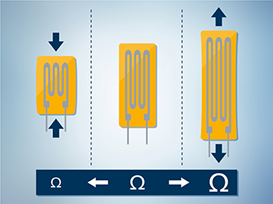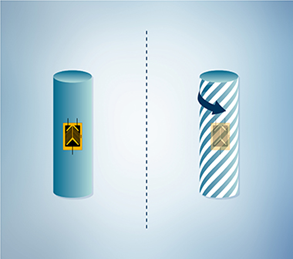 Force Sensor
Force Sensor
 Load Cell
Load Cell
 Torque Force Sensor
Torque Force Sensor
 Multi-axis Force Sensor
Multi-axis Force Sensor
 Piezoelectric Force Sensor
Piezoelectric Force Sensor
Although torque sensors are available in various designs, they all have a few things in common. To understand how torque sensors work, let’s have a look at the design of the sensors.
A Brief Trip Through Strain Gauge Technology
Like many other kinds of sensors, torque sensors use strain gauge technology for measurement. The sensor consists of a measuring body, generally of metal, on which strain gauges (SG) are mounted. These consist of a thin foil and an electrical conductor that is firmly connected to the foil. As the foil (the conductor) changes shape, the electrical resistance also changes. This reveals how much load is currently acting on the SG.
If an external load acts on the sensor, the strain gauge deforms as does the spring element – and measurement can commence. This applies not only to torque transducers, but also to load cells, force sensors, and other types of sensors. However, torque sensors have a few special features.

If a strain gauge is compressed, its electrical resistance (Ω) decreases; if it is stretched, the resistance increases.
Two Typical Torque Sensor Designs
Unlike load cells or force sensors, the measuring body of a torque sensor is not subject to tension or compression when in use, but to torsion. The sensor is not exposed to a force acting from one or two opposing directions, but rather a lever force, or torque. Therefore, torque sensors are also fitted with special strain gauges that can record this type of load, that is, torsion, very well. Two typical torque transducer designs are the measurement shaft and the measurement flange。

The measuring body twists under load.
Torque Measurement Shaft
The measurement shaft consists of a shaft, which may also be hollow. The SGs are mounted here – sometimes on a tapered section in the middle, for example, depending on the version. The shaft is enclosed by a housing. The shaft, or rotor, moves while the housing, or stator, is fixed. Both parts are interconnected by low-friction, zero-play bearings. The sensor can be incorporated in a structure or test bench by means of hub-type clamps on both ends of the shaft. These are available in various shapes and sizes。

Simplified representation of a torque measurement shaft.
Torque Measurement Flange
Measurement flanges basically have a similar structure to measurement shafts, but look completely different. They too consist of a mostly hollow shaft, although this is extremely short. Flanges are situated at both ends of the shaft. These enable the transducer to be integrated into a structure or test bench by means of a threaded connection. Measurement flanges also consist of a rotor and stator. However, unlike in measurement shafts, the rotor is not entirely enclosed in the housing. Therefore, no bearing assembly is needed because the rotor is securely installed in the measurement section。

Simplified representation of a measurement flange.
Non-Contact Measured Data Transmission
This is where we see the biggest difference between rotating torque sensors and other sensors such as force sensors or load cells. In torque sensors, cables supplying power and transferring measurement data cannot be used because the cables would become entangled as the rotor turns. To avoid this, energy is transferred from the stator to the turning rotor using a contactless connection, which in turn supplies the mounted SG measuring bridge. In return, the turning rotor transfers the measured data to the stator via telemetry.
Electronics are housed in the measuring body. Here, the signal from the SG measuring bridge is amplified, filtered, and digitized before being wirelessly transferred to the stator. The data can then be output either via a frequency or voltage signal or digitally via a fieldbus, for example, with Ether CAT or Profinet, depending on the application.
Rotating or Non-Rotating Torque Measurement
The sensor doesn’t always rotate when measuring torque. Typical examples of non-rotating setups are standard test machines and measurements on mixers. In the latter, the sensor is supported by the housing of the electric motor, and the drive shaft runs through a central hole in the sensor.
In most applications, the sensor is part of the rotating drivetrain between the test specimen and the dynamometer. The specimen could be an internal combustion engine, a gearbox, or an electric motor, for instance.
Static and Dynamic Torque Measurement
Torque can be measured statically or dynamically. An example of a dynamic measurement could be the pulsating torque generated when rotating elements are continually accelerated and then slowed down (or ‘braked’), or through the power stroke of an internal combustion engine. What’s more, dynamic torque can also occur completely without rotation. However, in most applications – such as engine test benches (internal combustion engine or electric motor) – dynamic torque occurs in connection with rotation.